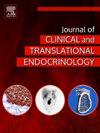Association between cardiometabolic index and sarcopenia: 2011–2018 National Health and Nutrition Examination survey (NHANES)
IF 3.3
Q1 ENDOCRINOLOGY & METABOLISM
Journal of Clinical and Translational Endocrinology
Pub Date : 2025-08-19
DOI:10.1016/j.jcte.2025.100415
引用次数: 0
Abstract
Background
The cardiometabolic index (CMI) is a reliable marker used to assess the degree of obesity and lipid metabolism disorders in individuals. Emerging evidence indicates that disorders of lipid metabolism and sarcopenia share a common pathophysiologic basis. However, few studies have investigated the association between CMI and sarcopenia. Therefore, this study aimed to find the possible correlation between CMI and sarcopenia.
Methods
This study used cross-sectional research methods to investigate data on CMI, sarcopenia, and other covariates among participants in the National Health and Nutrition Examination Survey (NHANES) from 2011 to 2018. We explored the relationship between CMI and sarcopenia through multivariate linear and logistic regression, and we performed sensitivity and subgroup analyses. Also, receiver operating characteristic (ROC) curve analysis and area under the curve (AUC) were utilized to evaluate the performance of CMI in identifying sarcopenia.
Results
Of the 4,808 adults aged 20 to 59 included in this study, 428 (8.90 %) were identified as having sarcopenia. A significant nonlinear association between CMI and sarcopenia was demonstrated in a generalized additive model (GAM). After inclusion of all covariates, CMI showed a significant association with the prevalence of sarcopenia (OR = 1.173(1.086–1.267), P < 0.001). CMI got an AUC of 0.69 in identifying sarcopenia. Finally, subgroup analyses showed that the association between CMI and sarcopenia was particularly pronounced in individuals who differed in marital status, poverty-to-income ratio, alcohol consumption, patients without diabetes, and patients with hypertension (P < 0.05).
Conclusion
This study demonstrated that an elevated CMI was associated with an increased prevalence of sarcopenia. The finding suggests that CMI could serve as a potential marker for sarcopenia, highlighting the need for further research to explore the relationship between dyslipidemia and sarcopenia.
心脏代谢指数与肌肉减少症的关系:2011-2018年全国健康与营养调查(NHANES)
背景:心脏代谢指数(CMI)是评估个体肥胖和脂质代谢紊乱程度的可靠指标。新出现的证据表明,脂质代谢紊乱和肌肉减少症具有共同的病理生理基础。然而,很少有研究调查CMI与肌肉减少症之间的关系。因此,本研究旨在寻找CMI与肌肉减少症之间可能存在的相关性。方法本研究采用横断面研究方法,对2011 - 2018年国家健康与营养检查调查(NHANES)参与者的CMI、肌肉减少症和其他协变量数据进行调查。我们通过多元线性和逻辑回归探讨了CMI和肌肉减少症之间的关系,并进行了敏感性和亚组分析。此外,采用受试者工作特征(ROC)曲线分析和曲线下面积(AUC)来评价CMI识别肌少症的性能。结果在本研究纳入的4808名20至59岁的成年人中,428人(8.90%)被确定患有肌肉减少症。在广义加性模型(GAM)中,CMI和肌肉减少症之间存在显著的非线性关联。纳入所有协变量后,CMI显示与肌肉减少症患病率显著相关(OR = 1.173(1.086-1.267), P < 0.001)。CMI鉴别肌少症的AUC为0.69。最后,亚组分析显示,在婚姻状况、贫困收入比、饮酒、非糖尿病患者和高血压患者中,CMI与肌肉减少症之间的关联尤为明显(P < 0.05)。结论:本研究表明CMI升高与肌少症患病率增加有关。这一发现表明CMI可以作为肌肉减少症的潜在标志物,强调需要进一步研究血脂异常和肌肉减少症之间的关系。
本文章由计算机程序翻译,如有差异,请以英文原文为准。
求助全文
约1分钟内获得全文
求助全文
来源期刊

Journal of Clinical and Translational Endocrinology
ENDOCRINOLOGY & METABOLISM-
CiteScore
6.10
自引率
0.00%
发文量
24
审稿时长
16 weeks
 求助内容:
求助内容: 应助结果提醒方式:
应助结果提醒方式:


